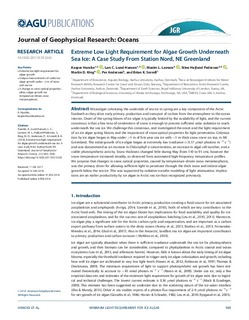| dc.contributor.author | Hancke, Kasper | |
| dc.contributor.author | Lund-Hansen, Lars C. | |
| dc.contributor.author | Lamare, Maxim L. | |
| dc.contributor.author | Pedersen, Stine Højlund | |
| dc.contributor.author | King, Martin D. | |
| dc.contributor.author | Andersen, Per | |
| dc.contributor.author | Sorrell, Brian K. | |
| dc.date.accessioned | 2019-06-24T14:11:44Z | |
| dc.date.available | 2019-06-24T14:11:44Z | |
| dc.date.issued | 2018 | |
| dc.identifier.citation | Journal of Geophysical Research - Oceans. 2018, 123 (2), 985-1000. | nb_NO |
| dc.identifier.issn | 2169-9275 | |
| dc.identifier.uri | http://hdl.handle.net/11250/2601923 | |
| dc.description.abstract | Microalgae colonizing the underside of sea ice in spring are a key component of the Arctic foodweb as they drive early primary production and transport of carbon from the atmosphere to the ocean interior. Onset of the spring bloom of ice algae is typically limited by the availability of light, and the current consensus is that a few tens‐of‐centimeters of snow is enough to prevent sufficient solar radiation to reach underneath the sea ice. We challenge this consensus, and investigated the onset and the light requirement of an ice algae spring bloom, and the importance of snow optical properties for light penetration. Colonization by ice algae began in May under >1 m of first‐year sea ice with ∼1 m thick snow cover on top, in NE Greenland. The initial growth of ice algae began at extremely low irradiance (<0.17 μmol photons m−2 s−1) and was documented as an increase in Chlorophyll a concentration, an increase in algal cell number, and a viable photosynthetic activity. Snow thickness changed little during May (from 110 to 91 cm), however the snow temperature increased steadily, as observed from automated high‐frequency temperature profiles. We propose that changes in snow optical properties, caused by temperature‐driven snow metamorphosis, was the primary driver for allowing sufficient light to penetrate through the thick snow and initiate algae growth below the sea ice. This was supported by radiative‐transfer modeling of light attenuation. Implications are an earlier productivity by ice algae in Arctic sea ice than recognized previously. | nb_NO |
| dc.language.iso | eng | nb_NO |
| dc.publisher | American Geophysical Union | nb_NO |
| dc.title | Extreme Low Light Requirement for Algae Growth Underneath Sea Ice: A Case Study From Station Nord, NE Greenl and | nb_NO |
| dc.type | Journal article | nb_NO |
| dc.type | Peer reviewed | nb_NO |
| dc.description.version | publishedVersion | nb_NO |
| dc.rights.holder | © 2018. American Geophysical Union | nb_NO |
| dc.source.pagenumber | 985-1000 | nb_NO |
| dc.source.volume | 123 | nb_NO |
| dc.source.journal | Journal of Geophysical Research - Oceans | nb_NO |
| dc.source.issue | 2 | nb_NO |
| dc.identifier.doi | 10.1002/2017JC013263 | |
| dc.identifier.cristin | 1626212 | |
